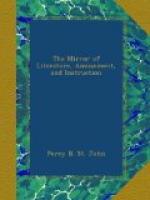Then turning to the Bishop, he said, “I have a good cause, and a gracious God on my side.”
“The Bishop. There is but one stage more, this stage is turbulent and troublesome, it is a short one; but you may consider it will soon carry you a very great way, it will carry you from earth to heaven; and there you will find a great deal of cordial joy and comfort.”
“The King. I go from a corruptible to an incorruptible crown, where no disturbance can be, no disturbance in the world.”
“The Bishop. You are exchanged from a temporary to an eternal crown; a good exchange.”
Then the King said to the executioner, “Is my hair well?” and took off his cloak and his George, giving his George to the Bishop, saying, “Remember.” Then he put off his doublet, and being in his waistcoat, he put on his cloak again; then looking upon the block, he said to the executioner, “You must set it fast.”
“Executioner. It is fast, Sir.”
“The King. When I put out my hands this way (stretching them out), then—” After that, having said two or three words to himself, as he stood with his hands and eyes lift up, immediately stooping down, he laid his neck upon the block.[7] And then the executioner again putting his hair under his cap, the King, thinking he was going to strike, said, “Stay for the sign.”
[7] It being doubted whether the king would submit to the executioner, staples were driven into the block, and hooks prepared, in order, if necessary, to confine his head forcibly to the block. On the trial of Hugh Peters in 1660, it was sworn that this was done by his orders given on the scaffold to one Tench, a joiner; in Houndsditch. See State Trials, vol. v.
“Executioner. Yes, I will, and please your Majesty.”—After a little pause, the King stretching forth his hands, the executioner at one blow severed his head from his body, and held it up and showed it to the people, saying, “Behold the head of a traitor!” At the instant when the blow was given, a dismal universal groan was uttered by the people (as if by one consent) such as was never before heard; and as soon as the execution was over, one troop of horse marched rapidly from Charing Cross to King Street, and another from King Street to Charing Cross, to disperse and scatter the multitude.
Though Joyce and Hugh Peters have been suspected of inflicting the murderous blow on Charles, and though another claimant for this infamous distinction is put forward in the Gentleman’s Magazine for 1767, there seems little doubt that Richard Brandon, the common hangman, assisted by his man, Ralph Jones, a ragman in Rosemary Lane, in fact perpetrated the deed. Among the tracts relative to the Civil War presented to the British Museum by George III., in 1762, are three on this subject, which are fully noticed in a note to Mr. Ellis’s Letters on English History, vol. iii. (second series.) It appears, by the register




